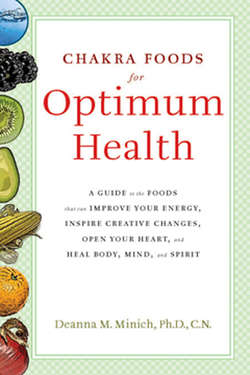Читать книгу Chakra Foods for Optimum Health - Deanna M. Minich - Страница 13
На сайте Литреса книга снята с продажи.
FOOD BEYOND THE CALORIE
ОглавлениеAlthough there is much recent news about food being capable of affecting us on many levels (physical, emotional, mental, and spiritual), this realization was brought to light thousands of years ago by ancient traditions like East Indian Ayurvedic medicine and traditional Chinese medicine. In both these traditions, balancing the energetic properties of different foods in the diet is strongly emphasized. For example, in Chinese medicine, foods are selected according to their warming, cooling, drying, or moistening effects on the body. To the novice, it would be relatively easy to intuitively select foods that embody certain properties, as the principles parallel the concepts found in nature. For instance, in general, “warming” foods are those that rev metabolism and create heat in the body. Curried chicken is a good example of a warming food, as it is an animal product and includes seasoning. Both features make the chicken a “hot” food, and it is usually recommended that individuals with a “warm nature” or who are prone to overheating moderate their consumption of these foods. On the other hand, cooling foods would be those that are more neutral in taste and tend not to be cooked, like sliced cucumber or tofu. In contrast to warming foods, they dampen the metabolism, slowing it down. Current Western medicine does not promote the use of foods to prevent disease as much as these other cultures do; however, this trend is changing with new “functional medicine” or “integrative (holistic) medicine,” which honors the inner communication between body systems and focuses on the individual as a whole.
Overall, the field of nutrition as a science has been very physically grounded in the basic elements of physiology—such as ingestion, digestion, absorption, transportation, utilization, and excretion of food substances—and the effect of these processes on health. Although physical aspects of food are emphasized in the nutritional paradigm, there is increasing research in the area of the emotional effects of eating. The remaining missing piece is the integration of our body needs with those of our soul and using the needs of one to heal the other. Some may suggest that many people in Western society are not in touch with their soul. It has been said that “illness is the Western form of meditation”— that we do not engage deeper, soulful parts of ourselves unless we are catastrophically provoked. Since chakras span the body and nonbody (soul) parts of our being, they are an excellent way to access the body-soul connection. By tapping into what our chakras are telling us, we are able to better make choices that support integration of our layers of being.
Understanding our health through our chakras enables us to move beyond ensuring that the body has physical food for energy to live by taking us into the realm of food as “spiritual sustenance” or “food for the soul.” The synergy of chakras and food provides a superhighway to accessing spirituality, or our interconnectedness with all of life. Together, the chakras and food help us to recognize that life is greater than the sum of its parts. When we shed the idea of food being functional and replace it with choosing to eat to feel the gentle weblike connection with all of life, food takes on a note of Divinity and sacredness. Many cultures and religions have created spiritual practices—such as giving thanks (“grace”) for the meal— around eating as a way of acknowledging this sacred act.
Understanding our health through our chakras enables us to move beyond ensuring that the body has physical food for energy to live by taking us into the realm of food as “spiritual sustenance” or “food for the soul.”
